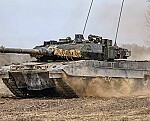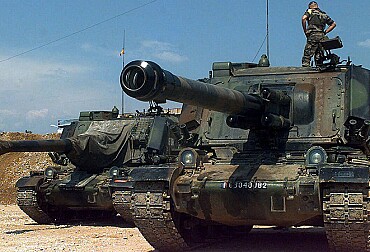Brazil is looking for new combat vehicles. The Poles may have solution, but lack production capacity
The Brazilian Armed Forces are seeking new armored combat vehicles, including Infantry Fighting Vehicles (IFVs) and Main Battle Tanks (MBTs), to replace their aging equipment. Sweden, Spain, Singapore, China, and Poland might offer interesting solutions.
Brazil plans to purchase 78 Viatura Blindada de Combate de Fuzileiros (VBC Fuz), or Infantry Fighting Vehicles, and 65 Viatura Blindada de Combate Carro de Combate (VBC CC), which are either Main Battle Tanks or vehicles with comparable armament. These new vehicles will replace the aging Leopard 1A5BR and M60A3TTS Main Battle Tanks currently in service.
For Infantry Fighting Vehicles, designs under consideration include the CV90 (by BAE Systems), ASCOD 2 (GDELS), Hunter (by ST Kinetics, Singapore), and VN17 (a Chinese vehicle). Brazil might also consider the Polish Borsuk by PGZ, notable for its ability to traverse water obstacles by swimming, a valuable feature given Brazil’s specific geography. A market analysis is currently underway, with submissions due by December 20. The deadline for responding to the request for information on the 105mm howitzers Brazil also intends to purchase has been extended to the same date.


The CV90 Infantry Fighting Vehicle
The CV90 is a Swedish Infantry Fighting Vehicle developed by BAE Systems-Hägglunds. Its main armament depends on the variant and includes 30mm, 35mm, or 40mm automatic cannons. The most successful model, the CV9035, is armed with a 35mm Bushmaster III chain gun firing 35×228 ammunition at a rate of 200 rounds per minute. It features dual magazines for anti-tank and airburst ammunition. The cannon is capable of firing ABM/KETF airburst ammunition, making it effective against surface, land, and air targets. It also uses APFSDS anti-tank ammunition.
A 7.62mm FN MAG machine gun with 1,800 rounds (250 immediately accessible) complements the main weapon. The vehicle's armor protects against 14.5mm rounds from all sides and 30mm ammunition (of older Soviet origin) on its front. Powered by a 750hp Scania DI16 diesel engine coupled with a Perkins X300 Series x4 transmission, it achieves a top speed of 70 km/h despite weighing nearly 32 tonnes. The CV90 accommodates a three-person crew and up to six soldiers. This version is in service with Denmark, the Netherlands, Estonia, and has been ordered by Slovakia.
ASCOD 2 – Austrian Spanish Cooperation Development
The ASCOD was developed collaboratively by Austria’s Steyr-Daimler-Puch AG and Spain’s Santa Bárbara Sistemas, now part of GDELS. It has been in service since 2001 with the Spanish and Austrian armed forces under the names Pizarro and SPz Ulan, respectively. Equipped with a two-seater turret and a 30mm Mauser MK30-2 cannon, the ASCOD 2 chassis forms the foundation for the British Ajax family of combat vehicles, part of the Scout Specialist Vehicle program.
The large family of ASCOD vehicles is a versatile and powerful land platform for current and future operation theatres which is operated by various NATO members countries. The modular design architecture offers adaptability and scalability and is remarkably cost-efficient for maintenance. The modular design means the platform can be tailored to a customer’s specific needs and requirements. With different payload capacities and growth potential and its alternative power pack and running gear, ASCOD offers a wide range of configurations which cover all the major roles of an Armored Fighting Vehicle; Infantry Fighting Vehicle, Armored Personnel Carrier, Command Post, Forward Observer, Repair, Recovery, Engineering, Artillery 155/52 (DONAR), Direct Fire / Light Tank or Bridge launcher and can integrate all types of turrets and weapon systems.
The Hunter
The Hunter is a Singaporean Infantry Fighting Vehicle. The Hunter was developed as part of the New Generation Armoured Fighting Vehicle (NGAFV) programme by the Defence Science and Technology Agency (DSTA) and ST Engineering in cooperation with the Singapore Army. Development began in 2006 and the first presentation took place in July 2016. On 22 March 2017, the Singapore Ministry of Defence awarded ST Engineering the contract for series production, and the vehicles entered service with the local army in 2019. The vehicle is equipped with an unmanned (optionally manned) Israeli Rafael Samson 30 turret, armed with a 30mm ATK Orbital Mk 44 Bushmaster automatic cannon supplied with 230 rounds and a 7.62mm coaxial machine gun supplied with 500 rounds. The turret is also equipped with two retractable Rafael Spike LR/MR anti-tank missiles.
The vehicle weighs 29.5 t. It carries three crew members and up to eight infantrymen. The MTU 8V-199 TE20 engine produces 711 bhp and has a top speed of 70 km/h. The vehicle is equipped with the Army Battlefield Internet C4 (ABI) data transmission system. The vehicle could be derived as a light tank fitted with a turret from Belgian company CMI Cockerill armed with a 90 or 105 mm gun too.
VN17 from China
China's Norinco produces its heavy VN17 tracked Infantry Fighting Vehicle which resembles the CV90 or the ASCOD. It found almost no inspiration in older Chinese or Soviet designs, and is meant specifically for export. Unveiled in 2017, the vehicle shows similarities in design to China’s VT5 light tank. The 30-tonne tracked vehicle with composite armour is intended to outperform its predecessor, the ZBD-08, in all respects. The frontal armour is intended to withstand hits from 30mm-calibre armour piercing ammunition. It is also armed with a 30 mm gun and two HJ-12 anti-tank missile launchers. The secondary weapon is a 7.62 mm machine gun. It is to have modern optics and sensors. VN17 is manned by a crew of three and can carry up to seven soldiers. The engine (FX0012 turbo diesel of 1000 hp with a fully automatic transmission) is designed like the powerpack from the VT5 but is in the front so that the troop compartment can be in the rear, protected.
The Borsuk IFV
The Polish Borsuk IFV, based on a universal modular crawler platform (UMPG), is equipped with a remotely controlled turret system (ZSSW-30). It is crewed by 3 soldiers: a commander, an armament operator and a driver. The vehicle is designed to transport 6 soldiers to the battlefield region, ensuring an adequate level of protection. The vehicle has the ability to fight infantry, armoured vehicles, air targets and other objects in any weather conditions and at any time of day. Within the Polish Army the Borsuk IFV is expected to interact very effectively with subdivisions of the K2 family of tanks, which will enter the equipment of, among others, the 16th Mechanised Division.
Borsuk IFV is characterised by high mobility and ability to overcome terrain obstacles, including water obstacles by swimming and can be operated in various climatic conditions. The maximum speed when moving on paved roads is 65 km/h, when swimming, it is 8 km/h. The combat weight of the vehicle in the basic variant is 28 tonnes. A very important element of the Borsuk IFV is the ZSSW-30 remotely controlled turret system developed by Huta Stalowa Wola S.A. together with WB Electronics S.A., whose main armament is the Bushmaster Mk.44S automatic cannon. It allows fire with five different types of ammunition, including airburst ammunition. The secondary armament, integrated into the turret, is a modified 7.62mm UKM-2000C machine gun coupled to the cannon. Additional armament is also provided by a double anti-tank guided missile launcher.
Until the Polish Ministry of Defence signs an executive contract with the PGZ for the first production batch of the Borsuk IFV, finding export customers may be problematic. Let alone developing production capacity at Huta Stalowa Wola. And these, given the very large needs of the Polish Armed Forces, which amount to a total of 1,400 vehicles of all versions envisaged to date, require significant expansion and it is unclear whether spare capacity for export will be found.









